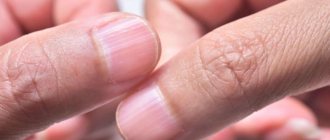Clinical manifestations
The disease can be determined by consulting a dermatologist by detecting dark brown or black spots, fibromas or papillomas, as well as signs of hyperkeratosis. The latter develops in response to exfoliation and roughening of the skin. The diagnosis requires clarification, especially since the disease is quite rare: with similar symptoms, it can easily be confused with other dermatological problems, wasting valuable time.
Manifestations are most often localized in the inguinal-femoral fold, on the elbows, on the skin of the armpits, in the intergluteal and popliteal areas, under the mammary glands. First, the surface darkens, then becomes rough, dry and thickens. The natural pattern takes on more pronounced features. At a later stage, the patient can seek help to remove papillomas in intimate places, however, if these formations are accompanied by tingling and mild itching, it is worth consulting with an experienced dermatologist first and undergoing additional tests.
Causes
There are the following groups of reasons why the skin on the face and body darkens:
- Increased production of melanocyte-stimulating hormone.
- Other internal diseases accompanied by metabolic disorders.
- Taking certain medications.
- Malignant tumors of internal organs.
Diagnosis and treatment
If the skin in certain areas has darkened and remains so for a long time, do not postpone a visit to the clinic. The specialist will perform a differential diagnosis, conduct a histological examination, and then confirm or refute the diagnosis.
Treatment is complex and involves both symptomatic measures and treatment of the underlying disease that provoked acanthosis. The patient may be prescribed vitamin complexes and restorative medications, anti-inflammatory ointments, zinc tablets, and baths with potassium permanganate. In severe cases, hormonal agents and cytostatics, antibacterial therapy and neurotropic drugs are used - always while following a strict diet. If the papillomas have grown seriously, they are removed.
If you discover darkening, do not put off your visit to the dermatologist. Sometimes this manifestation hides oncological diseases, which can still be affected at an early stage, while there are no general symptoms.
Skin hyperpigmentation
Thyrotoxicosis
18840 May 21
IMPORTANT!
The information in this section cannot be used for self-diagnosis and self-treatment.
In case of pain or other exacerbation of the disease, diagnostic tests should be prescribed only by the attending physician. To make a diagnosis and properly prescribe treatment, you should contact your doctor. Skin hyperpigmentation: causes of appearance, what diseases it occurs with, diagnosis and treatment methods.
Definition
Skin hyperpigmentation is an excess deposition of melanin pigment of varying location, shape and size, leading to changes in skin color of varying intensity.
The surface layer of the skin (epidermis) is a multilayered (five layers) epithelium. The largest number of melanocytes, the main function of which is the production of melanin, are located in the basal layer of the skin (basal membrane)
Thanks to melanin, the skin protects a person from ultraviolet and infrared radiation.
The formation of age spots largely depends on the condition of the basement membrane.
Types of skin hyperpigmentation
Based on
the mechanism of occurrence,
the following types of skin hyperpigmentation are distinguished:
- melanocytic - pigmentation occurs due to an increase in the number of melanocyte cells;
- melanin - pigmentation is caused by an increase in the production and accumulation of melanin or a decrease in the rate of renewal of the stratum corneum of the epidermis.
The accumulation of pigment can be limited
or
widespread
, caused by
physiological
or
pathological
reasons, the process can be primary or secondary.
Possible causes of skin hyperpigmentation
Scientists identify several main causes of skin hyperpigmentation:
- genetic predisposition;
- exposure to ultraviolet radiation (in isolation or in combination with other reasons);
- burns (thermal, chemical, electrical);
- inflammatory processes;
- infectious diseases, including parasitic ones;
- endocrine disorders;
- metabolic disorders;
- use of herbal substances and drugs with photosensitizing effects
freckles for people
(ephelides) are a striking example of a realized genetic predisposition, which is based on an increase in the formation of melanin.
What diseases cause skin hyperpigmentation?
The group of melanocytic pigmentations includes various types of lentigines
.
Simple lentigo occurs at any age as a single (or multiple) formation up to 5 mm in size, brown in color. Doesn't change over time.
For xeroderma pigmentosum
Lentigo occurs before the age of 2 years on areas of the skin exposed to the sun (face, neck, back of the hands), then spreads throughout the body. Often combined with keratosis - thickening and peeling of the skin.
Solar lentigo
Appears, as a rule, after 40 years of age on areas of the skin previously exposed to sunburn. They appear as spots ranging in size from 1 to 3 cm, their color can vary from light yellow to dark brown.
Lentigo reticularis
resembles a black blot and is considered a type of solar lentigo. Most often occurs in individuals with skin phototypes I and II who have a history of severe sunburn with blistering.
Less common are other types of lentigo, occurring in isolation under the influence of solarium lamps, drug therapy (PUVA lentigo) or as part of syndromes affecting other internal organs (for example, with Peutz-Jeghers syndrome, lentigo of the oral mucosa is combined with intestinal polyps).
Skin hyperpigmentation can occur due to hormonal imbalance.
For example, during pregnancy the level of estrogen increases, and against the background of exposure to ultraviolet radiation, chloasma can form - round spots of different sizes and colors on the face.
In the later stages of pregnancy, existing moles, freckles, nipples and areolas of the mammary glands, the white line of the abdomen, and the skin around the navel may darken. Chloasma is often observed in women taking hormonal contraceptives, as well as with inflammatory or tumor pathologies of the ovaries. Chloasma is rarely recorded in men - as a rule, they have an increased level of luteinizing hormone and a decreased level of testosterone.
Hyperpigmentation of the skin throughout the body with darker areas exposed to sunlight is seen in primary or secondary chronic adrenal insufficiency (Addison's disease or syndrome) due to low levels of the hormone cortisol.
As a result of excessive thyroid function (thyrotoxicosis), secondary adrenal insufficiency occurs, and pigmentation can be diffuse or limited in the form of chloasma.
In diseases accompanied by extreme exhaustion (cachexia), the skin of the neck, abdomen, and genitals turns dirty brown.
The pigment can accumulate in places of thermal, chemical or electrical burns, injuries with damage to the skin. The pigment often remains after resolved boils, carbuncles, urticaria, lichen planus, psoriasis, as well as after scabies and lice.
In Riehl's melanosis, a bluish-brown reticulate pigmentation appears on the back of the hands and forearms, and the same occurs when in contact with synthetic clothing, rubber products or hydrocarbons, enhanced by ultraviolet exposure.
Some plants (legumes, figs, parsley, citrus fruits) contain photosensitizing substances - psoralens.
When present in food, they increase the photosensitivity of the skin. Such plants can be included in cosmetics; if you apply them to the skin and then go out into the sun, hyperpigmentation will occur at the site of application. Some medications also have a photosensitizing effect: sulfonamides, tetracyclines, antipsychotics, etc. Taking cytostatics slows down the rate of epidermal renewal, so the pigment is removed more slowly.
Which doctors should I contact for hyperpigmentation?
If hyperpigmentation occurs, you should consult a dermatologist. If the examination reveals pathologies of internal organs, you may need to consult an endocrinologist, therapist, gynecologist, urologist and other specialists, and if there is a risk of malignancy of the process, an oncologist.
Diagnosis and examinations for skin hyperpigmentation
Diagnosis of hyperpigmentation is based on clinical examination and patient interviews.
If necessary, the doctor can remove a pigmented formation (for example, lentigo reticularis) followed by histological examination to confirm its benignity.
What symptoms indicate acanthosis? Forms of acanthosis nigricans
Acanthosis has several forms of progression depending on the cause, which determines the intensity of the development of the process. Dermatologists have identified 3 main forms of acanthosis nigricans:
- Juvenile or benign, which is associated with endocrine and genetic pathologies.
- Malignant or paraneoplastic, which develops with malignant tumors of internal organs.
- Pseudoacanthosis, which develops with obesity and metabolic disorders. This form disappears without a trace when weight is normalized and has the best prognosis.
Clinical manifestations of acanthosis have 3 main symptoms:
- Increased pigmentation - the appearance of black or dark brown spots on the skin.
- Papillomatosis is the presence of fibromas or papillomas on the skin, which are popularly called warts.
- Hyperkeratosis, which provokes roughening and exfoliation of the skin.
Earthy tint and sharp darkening of the skin - pancreatic disease or oncology
Changes of this kind indicate more serious illnesses. Often, of course, an earthy tint appears due to diseases of the pancreas, adrenal glands, or against the background of long-term use of antibiotics, but if such options are excluded, then the best recommendation in this case would be to turn to modern medicine. Diagnosis of the disease by the skin and on the basis of examinations will allow you to correctly and accurately determine the cause of the change in complexion, as well as timely diagnose the disease that provoked it.










